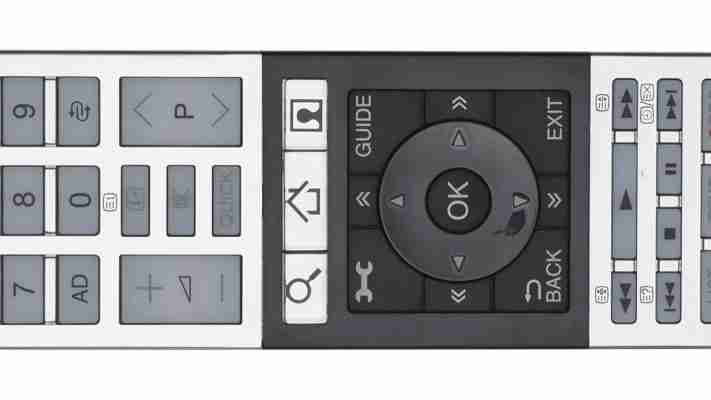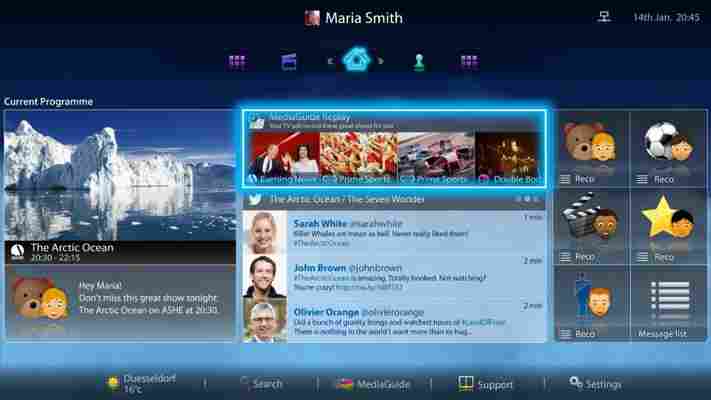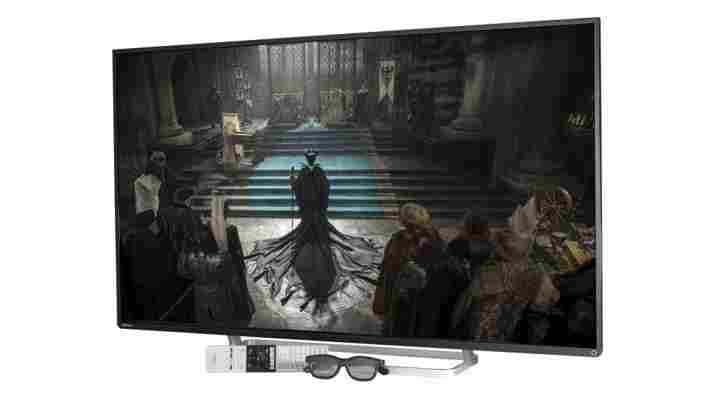Toshiba TVs tend to be cheaper than other big-name manufacturers, making them attractive sets for those on a budget. The L7453DB, Toshiba's flagship Full HD TV this year, is no different, with prices ranging from £600 for the 42in model up to £1,000 for the 55in version. This isn’t bad considering other manufacturers tend to match those prices on their mid-range TVs, and with passive 3D the whole family can enjoy 3D content (with four pairs of glasses thrown in).
For this review we tested the 47in model in the L7453DB range, but it's also available in 42in (42L7453DB) and 55in (55L7453DB) screen sizes. All models have identical specifications except for their dimensions and power usage. We're confident that image quality will be practically identical across the range.
We're big fans of the L7453DB's design. With its slim bezel and matt metallic stand, this is a smart yet understated TV that greatly improves on the chunky, plastic frames of last year's models. There’s a great selection of ports round the back, too. You’ll find four HDMI inputs along with SCART, VGA, component and composite inputs, two USB ports, a CI slot, a 3.5mm audio line in, a 3.5mm headphone jack and an Ethernet port. The L7453DB also comes with integrated Wi-Fi and supports steaming over DLNA and Intel’s Wi-Di technology.
Unfortunately, that low price doesn't come without a few compromises, as the L7453DB's default screen quality isn't quite as good as the competition. There are eight picture modes to choose from: Standard, Game, PC, Dynamic, AutoView and three Hollywood modes (Day, Night and Pro). We found that Hollywood Pro produced the most accurate colours, as our colour calibrator showed it was displaying 84.4 per cent of the sRGB colour gamut on its default settings. We were hoping for a slightly higher score straight out of the box as most flagship and top mid-range models we’ve tested have all scored around 90 per cent on their default settings. However, Standard by comparison was showing just 80.5 per cent, so we used Hollywood Pro throughout our testing.
Hollywood Pro also produced the best black levels, measuring a respectable 0.12cd/m2. We’ve seen better from more expensive TVs, but this is still perfectly acceptable. Blacks were a touch grey in places, particularly in film letter boxes, but enabling the active backlight control and adjusting the black/white level option in the Advanced Picture menu soon fixed this.
The TV’s main area of weakness was its low contrast levels, as despite measuring 969:1, we found it difficult to see a high level of detail in dark night scenes in our Star Trek test footage. We managed to improve this somewhat by altering the basic contrast and backlight settings, but it still wasn’t as bright and detailed as our reference TV, which made watching TV with the lights on a little more difficult. This wasn’t helped by Hollywood Pro’s low brightness level of just 113.69cd/m2. Increasing the basic brightness control helped a little, as did switching off the auto brightness sensor, but setting the brightness level too high just made the screen look white and milky.
To calibrate the TV, we used the Expert Picture menu’s 10-point white balance setting. We didn’t make much headway with the TV’s overall brightness settings, but we did manage to increase the colour accuracy of both the Hollywood Pro and Standard picture modes to a much more respectable 93.2 per cent and 94.9 per cent respectively. This shows the L7453DB certainly has the potential to produce a great image as long as you're willing to put in the work or have a calibrator to hand, but it’s a shame it doesn't produce this kind of image straight out of the box.
The L7453DB's noise reduction settings also did very little when we switched to watching standard definition content. However we set the noise reduction and super resolution options, TV shows still looked quite fuzzy and smoothed over. HD channels looked better, but even here there were still patches of detail interspersed with sections of smooth haze.
More impressive was the L7453DB’s ClearScan feature. This is Toshiba’s frame interpolation setting, which inserts extra artificial frames to make footage appear smoother and less juddery. Normally, raising frame interpolation too high can make films start to tear or produce ghosting effects as the TV’s image processing struggles to keep up, but here the L7453DB managed beautifully on each different setting, producing smooth, clean camera movements even in heated action scenes. High was perhaps a little too aggressive during more sedate conversation sequences, but it’s by far one of the most flexible frame interpolation features we’ve seen.

The L7453DB’s passive 3D capabilities were also excellent. We didn’t see any signs of crosstalk when watching our Blu-ray of Avatar and we were able to get a clear picture no matter where we sat. The 3D judder cancellation feature wasn’t quite as effective as the 2D-only ClearScan feature, though, as there were a few moments when we saw a few bits of tearing start to creep in. We were also a little disappointed that there weren’t any options to change the depth of field – this is locked and greyed out in the 3D menu settings – but it’s a small complaint overall.
One area where the L7453DB fails to improve, though, is Toshiba’s Smart TV interface. Admittedly, menus were much quicker to load than last year’s models, but it still felt clunky and slow compared to the competition. You’ll also need to connect the TV to the internet before you can use the home menu properly, as it locks itself into demo mode if you don’t update it.
The main home screen is dominated by a large TV-related Twitter feed in the centre of the page while personalised profiles, each with their own rather twee and pixellated-looking icon, and channel recommendations fill the rest of it. All the apps are hidden on the four other home screens, but it’s unlikely you’ll need to use more than one of them as there aren’t that many core services to choose from. There’s BBC iPlayer, Netflix and BlinkBox for catch-up and on-demand TV, but that’s more or less it.

The Media Guide is likely to hurt your eyes, too, with its cacophony of colour-coded programmes. With so many colours onscreen, we found it actually made it more difficult to pick out TV shows, particularly when some of them weren’t even labelled correctly. A children's show, The Story of Tracy Beaker, was categorised as sport and came up green, while half of the BBC News channel was correctly identified as blue news while the other was simply classed as a grey “other”.
The TV supports a wide range of file formats if you want to watch content from an external flash drive, though, as our MPEG, MP4, MOV, MKV, DIVX, XVID, AVI and WMV files all worked perfectly, as did our MP3, AAC, WMA, WAV and OGG audio files.
On balance, though, the Toshiba L7453DB ultimately feels a little too flawed to really compete with the rest of the competition. The screen’s image quality has the potential to stand alongside its more expensive rivals, but you’ll need to spend time tweaking the picture settings in order to get it there, and its Smart TV content feels very limited and clunky. When you compare it to the £750 LG 47LB730V, there's simply no competition.
| HARDWARE | |
|---|---|
| Screen size | 47in |
| Native resolution | 1,920x1,080 |
| Aspect ratio | 16:9 |
| 3D | Passive |
| Contrast ratio | 1600:1 |
| Brightness | 700cd/m2 |
| Speakers | 30W |
| Video inputs | 4x HDMI, VGA, SCART, component, composite |
| Audio inputs | 3.5mm stereo |
| Audio outputs | Optical S/PDIF |
| Tuner | Freeview HD |
| Streaming TV services | BBC iPlayer, Netflix, BlinkBox |
| Media Streaming | DLNA, Intel Wi-Di |
| Dimensions | 662x1,071x190mm |
| BUYING INFORMATION | |
| Price including VAT | £750 |
| Warranty | Five-years RTB |
| Supplier | www.cramptonandmoore.co.uk |
| Details | www.toshiba.co.uk |
| Part code | 47L7453DB |













